 |
 |
|
 |
New bridge in Fargo-Moorhead cements link between Minnesota, North Dakota |
 |
 |
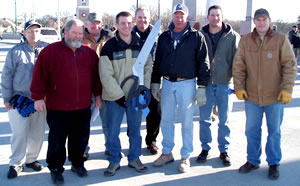 |
|
District 4’s bridge crew members take a moment from their work on the bridge for a photo: from left they include: Arlen Ottman, design, Bridge Office; Tim Swanberg, inspector; Scott Oines, chief inspector; Seth Yliniemi, bridge engineer; Tom Swenson, design project manager; Steve Rice, chief inspector; Jeff Perkins, resident engineer, and Matt Anderson, inspector. Photo by Kent Barnard
|
Warmed by the slanting November sun and an enthusiastic gathering of about 500 people, government officials opened the new Main Avenue Bridge that carries Hwy 10 over the Red River of the North between Moorhead and Fargo, N.D., on Nov. 24.
The project is a joint venture by the Minnesota and North Dakota DOTs and the cities of Fargo and Moorhead. Mn/DOT served as the project’s lead agency.
The opening followed a ceremony 18 months ago when many of the same officials and community leaders picked up sledgehammers for the “bridge breaking” that signaled the end for the old bridge built in 1936.
This time, celebrants wielded only small scissors to cut a bright purple ribbon.
Speakers referred to the new span as a literal connection of the two cities and a symbolic joining of the region and the two states’ pursuing economic, educational and cultural goals to benefit citizens far beyond the newly joined downtown areas.
Speakers included U.S. Sen. Byron Dorgan of North Dakota; U.S. Reps. Collin Peterson, Minnesota, and Earl Pomeroy, N.D., the mayors of each city and Bob Winter, Mn/DOT's District Operations Division director.
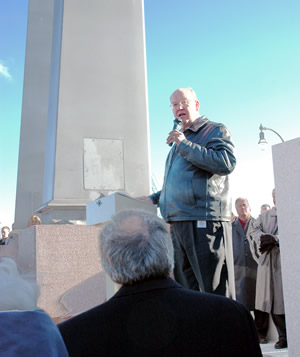 |
Bob Winter, District Operations director, spoke during the dedication ceremonies for the new Main Avenue Bridge on the structure’s public plaza. Photo by Kent Barnard |
“This is a long-term project for the region that will enhance mobility, safety, flood control and economic development,” Winter said.
Using design cues from each city, including granite pier towers that echo nearby church spires, the structure also features a mid-span plaza where pedestrians and bicyclists can meet while they view landmarks visible from the bridge.
On the Moorhead side, the approach to the new bridge eliminates a troublesome intersection with Third Street and creates space for a public plaza. A similar plaza is under construction on the Fargo side of the river. The plazas will define the bridge and welcome people to explore the riverfront.
The 806-foot-long bridge serves as a beacon to welcome visitors at night. Streetlights outline its length; additional lights brighten the mid-span plaza. The pier towers on each end are illuminated and fiber-optic beams reflect from each tower, creating a shimmering image above the bridge.
In addition to its amenities, the muscular steel-girder structure features wider driving lanes, a deck that will carry an estimated 30,800 vehicles per day by 2030 and a higher clearance over the river to lessen potential damage from flooding and floating debris.
Following the ceremony, Winter and Lee Berget, District 4 engineer, congratulated the Mn/DOT construction crew for their work.
By Craig Wilkins
|
back

|
 |
Hiawatha LRT to reach final destination on Dec. 4 |
 |
 |
This Saturday’s errand runs may include a shopping trip to the Mall of America for riders on the Hiawatha light rail transit line in Minneapolis. That’s when service on the line will extend southward from Fort Snelling to the mall and to the Minneapolis-St. Paul International Airport.
The additional four miles of track will also provide access to the Bloomington Central Station, a new development area, and a new park and ride lot at 28th Avenue in Bloomington.
With the new extension, the completed line now stretches about 12 miles and includes 17 stations along its route.
Hiawatha line trains will travel through twin tunnels under the airport to provide service to the Lindbergh passenger terminal and the Humphrey charter terminal.
Vicki Barron, Mn/DOT’s Hiawatha LRT project manager, said completion of the Hiawatha line marks a milestone in the renaissance of rail transportation in the Twin Cities metropolitan area. The LRT service, she said, creates a viable option for visitors, tourists, commuters and other travelers to go downtown, attend games at the Metrodome, shop at MOA or commute to work or school.
She expressed optimism that the Hiawatha line would lead to a system-wide approach to transportation options within the region.
Barron said the engineering challenges such as building the airport tunnels and installing underground facilities in downtown Minneapolis made constructing the line a rewarding experience for all those involved in the project.
Public response to the project, including ridership well above predicted levels, also makes the work fulfilling, she said.
“With construction of the line completed,” she said, “I am confident that our partners at Metro Transit will operate the system safely and effectively, providing commuters and other travelers with an exciting new resource to meet their mobility needs.”
For more information about the Hiawatha line, see Mn/DOT’s Web site and the Metro Transit Web site.
By Craig Wilkins
Free transit rides offered on line Dec. 4-5
All rides on Metro Transit buses and trains are free on Saturday, Dec. 4, and Sunday, Dec. 5.
Parking is available at public lots downtown and at these free Park & Ride lots:
- 28th Avenue Station—82nd Street & 28th Avenue South in Bloomington, just east of Mall of America
- Fort Snelling Station—Near Hwy 55 & Hwy 62 (Crosstown) in Minneapolis
- Lake Street/Midtown Station—Southeast corner of Hiawatha Avenue and Lake Street in Minneapolis
Click here for a schedule of public events on Dec. 4.
|
|
back

|
 |
Federal funding delays slow two major projects |
 |
 |
Delays on a new, long-term federal funding and policy act are affecting Mn/DOT’s ability to balance the Trunk Highway Fund as required by state law, said Lt. Gov. Carol Molnau.
The uncertainty of resolving the issue prompted an announcement last week that two major projects in the Twin Cities metro area—the Interstate 494/Hwy 169 interchange and the I-694/I-35E project—are being pushed back one year in their construction schedules.
Molnau expressed her concerns directly to Minnesota’s congressional delegation. She urged them to pursue early action in 2005 on a new, long-term federal transportation funding and policy act.
“The lack of a reauthorization bill and the piecemeal fashion in which funding has been distributed to states under the short-term extensions have had significant negative impacts on Minnesota’s transportation programs,” Molnau said in a letter sent last week to all members of the delegation.
Minnesota received $400 million in federal funds during the past budget year to support state and local road-building and transit programs. Molnau said Minnesota was shorted about $70 million in the past budget year and could miss out on $80 million next year, making construction planning and scheduling unpredictable.
The funding delays are also leading the department to trim $17 million in internal costs to help balance the Trunk Highway Fund by the end of the fiscal year.
“Although district and office budgets will be tight, no layoffs are associated with the budget adjustment. Some positions may remain unfilled, plans to purchase equipment may be dropped or delayed and all spending will be scrutinized,” said Scott Peterson, Finance director.
Congress allocates spending and writes policies for transportation in long-term legislation typically approved every six years. The last such law expired in September 2003. Since then, lawmakers have only been able to agree on a series of temporary extensions but not on legislation that would set new policies or increase spending.
The state Trunk Highway Fund provides dedicated highway funding to Mn/DOT. It is separate from the General Fund, which supports other state agencies and small programs within Mn/DOT such as transit, aeronautics and freight and commercial vehicle operations.
Follow this link to read the lieutenant governor's letter to the Minnesota congressional delegation.
By Jeanne Aamodt
|
back

|
 |
State budget forecast called "manageable" |
 |
 |
Finance Commissioner Peggy Ingison Dec. 1 presented the state budget forecast for fiscal 2006-07 in which economists now predict a $700 million shortfall.
Gov. Tim Pawlenty said the forecast contained "good news" for the current budget cycle, but also identifies a projected future challenge that Pawlenty called "manageable.” His complete comments can be found on the Northstar Web site.
The State of Minnesota operates on a two-year budget cycle referred to as the biennium. State fiscal years begin on July 1 and end the following June 30. More information, including the budget forecast announcement and state budget basics, can be found on the Department of Finance Web site.
|
back

|
 |
Design-build program breaks new ground |
 |
 |
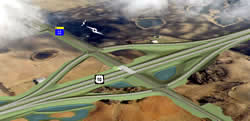 |
|
The goal of the Hwy 10/Hwy32 project is to reduce the number of crashes, fatalities and injuries at the intersection near Hawley while preserving mobility along the Hwy 10 corridor. The new interchange will replace the existing at-grade intersection. |
The Nov. 19 bid opening for a design build project to reconstruct the Hwy 10 and Hwy 32 intersection in District 4 was groundbreaking in more ways than one, according to Joe Gladke, design-build program director.
When the bids were opened, there were the usual gaps between high and low bids from the five bidders on the project. But for first time in Mn/DOT’s experience with the design-build bidding process, the proposer with the lowest bid was not selected.
That’s because another proposer—Duininck Brothers, Inc. as prime contractor with major participation from Mathiowetz Construction company and WSB and Associates—received a higher technical score. Design-build projects are awarded using a formula that divides the dollar value of the bid by the technical score to determine which bid is the best value for the project.
“The technical score is determined by how well the contractors satisfy criteria relevant to the project, such as team organization and key personnel experience, project management approach, schedule, quality, maintenance of traffic and geotechnical solutions,” Gladke said.
“This award was the first of its kind,” he added. “On previous design-build projects, the low-bid proposer always had the highest technical score, too. This is the first time the best value overturned the low bid.”
The project is also unique in its scale.
“With a cost estimate of $8.5 million, the project, which includes adding a full interchange at an existing at-grade intersection, is smaller than most design-build projects,” Gladke said. In contrast, the Interstate 494 design-build project in the Twin Cities metro area has a cost of more than $135 million.
“Improvements to the Hwy 10/Hwy 32 intersection near Hawley were originally scheduled for 2009,” said Trudy Kordosky, Detroit Lakes/District 4 project manager.
“Because the intersection had a high rate of crashes, the project was selected as one of the safety and preservation projects advanced under the 2003 Pawlenty-Molnau Transportation Finance Bill, accelerating it by three years. The project was then advanced an additional year using design-build contracting. Construction is now scheduled to begin in 2005,” she said.
“There has been an average of one fatality a year at the intersection during the past four years,” Kordosky said. “By moving it forward we can save time and, more importantly, we might save lives.”
For more information and project updates, visit www.th10-32.com.
By Kay Korsgaard
|
back

|
 |
Mississippi River shipping season ends with sharp drop in grain traffic |
 |
 |
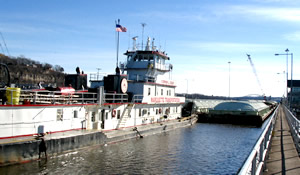 |
|
The Stephen L. Colby enters Lock and Dam #2 at Hastings as it guides the last loads of grain downriver to end the 2004 shipping season on the Mississippi. Photo by Dick Lambert |
Pushing four barges containing petroleum products, the Mike Kennelly was the last towboat to head downriver this year, ending the shipping season on the Mississippi River Nov. 29.
The last grain shipment left St. Paul on Nov. 24 when the Stephen L. Colby departed with 15 loads of corn and soybeans.
The tow operators usually end the season around Thanksgiving to avoid encountering ice build-up on the river.
Grain shipments by river dropped by nearly one half, from 7.5 million tons in 2003 to about 4 million tons this year, said Dick Lambert, Ports and Waterways Section director.
Lambert attributes the drop to high rates for ocean-going freighters sparked by rapid growth of freight shipments to China to fuel that nation’s rapidly growing economy.
Rather than move commodities overseas via the Gulf of Mexico for transshipment by ocean freighters to Asian markets, Lambert said many shippers chose to send commodity shipments by rail to Pacific Northwest seacoast ports. That tactic, he said, was less expensive than shipping grain by ocean from the Port of New Orleans.
The shipment of other commodities by river remained at about the same levels as last year, Lambert said.
Each year, river barges move about 17 million tons of freight on the Mississippi River into and out of Minnesota. Inbound products include aggregates such as sand and gravel, fertilizers, cement, coal and caustic soda, a chemical used in many manufacturing processes.
The primary commodity shipped out of the state is grain. Grain shipments average about nine million tons per year. Other products shipped from Minnesota include potash, asphalt, scrap iron and petroleum.
Lambert said while grain shipments by river declined, overseas shipment of grain, mainly wheat, from the Port of Duluth-Superior via the St. Lawrence Seaway, held at the about the same level as last year’s seven million tons.
“Variations in world commodity markets and shipping rates affect the entire Upper Midwest,” Lambert said. “This year’s drop in grain shipments on the Mississippi and the subsequent shift to Western ports shows that we are indeed part of a world economy.”
By Craig Wilkins
|
back

|
 |
Three districts recognized for work zone safety innovations |
 |
 |
 |
|
Workers on the Hwy 23 project combined portable water-filled barriers (at left) and portable concrete barriers to separate traffic from construction activity at this site near Spicer. Photo by Paul Jurek |
Innovations such as using portable concrete barriers on a rural construction project and turning a barrier-separated high occupancy vehicle lane into a traffic bypass earned Mn/DOT’s annual Work Zone Safety Awards for Willmar/District 8 and the Metro District.
They join staff from Rochester/ District 6 in sharing the awards given to recognize excellence and creativity that improved the safety of Mn/DOT employees and the public in work zones during the 2004 construction season.
District 8 received its award for setting the standard for the use of portable concrete barriers during reconstruction of Hwy 23 between Willmar and New London. The district’s construction staff also earned plaudits for its efforts to reduce traffic speeds in the project area, coordinate operations with the contractor and the State Patrol and lessen the project’s impact on communities such as Spicer.
Project engineers were Jim Christensen and Paul Jurek. Mark Pierskalla served as safety officer.
The Metro District was recognized for its work zone safety efforts during a mill and overlay project on Hwy 100 and Interstate 394. Initiatives cited include using the HOV lane on I-394 to carry traffic during operations, using full lane closures to reduce the time needed for the project and limiting the amount of work done under traffic.
Project engineer was Brien Konkol; chief inspector was Dale Feda.
Metro staff also received recognition for safety efforts while rebuilding I-494 from France Avenue to Hwy 169. The award panel cited the district’s incident management plan and its communications plan to notify the news media about road closures.
Project staff were also honored for creating connections between portable concrete barriers and existing structures, such as bridge piers, to improve crew safety and mobility.
Tom Villar and Andy Johnson served as project engineers. Chief inspectors were Mark Mondeel, Mark Mueske, Doug Wheeler and Bob Bobletter.
The panel honored District 6 for using the dynamic lane merge system while performing an overlay on I-35 in Rice and Scott counties and changing its application as the project progressed. The district also received recognition for working well with area business owners and the State Patrol to speed project completion.
Anthony Stakson served as project engineer; Duane Piepho served as chief inspector.
Staff from the Offices of Construction and Innovative Contracting and Traffic, Safety and Operations selected the award winners.
By Craig Wilkins
|
back

|
 |
Stan Ekern, former deputy commissioner, dies at 96 |
 |
 |
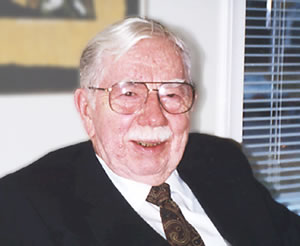 |
|
Stan Ekern, Mn/DOT deputy commissioner from 1969-73, died Nov. 16. Photo by Jan Ekern |
Stan Ekern, a key figure in Mn/DOT’s building the interstate highway system in Minnesota , died Nov.16 after a brief bout with cancer. He was 96.
Former colleagues recall Ekern as a thoughtful problem-solver with a gifted engineering mind and as a dedicated public servant.
His career with the department began in 1931 and ended in 1974 when he retired as deputy commissioner and chief engineer. During his tenure he held several engineering and management positions, including serving as the McLeod County engineer and district engineer at Detroit Lakes.
During World War II, Ekern served with the U.S. Navy. His assignments included providing security for the San Francisco Bay and the Bay Bridge.
Ekern was appointed as the assistant chief engineer in 1961 and as deputy commissioner and chief engineer in 1969.
Jan Ekern, Maintenance, the widow of Ekern’s oldest son, James, said Stan Ekern was a member of the self-described “famous class of 1931” at the University of Minnesota. The class included many graduates who went on to build significant careers in engineering, education and other endeavors.
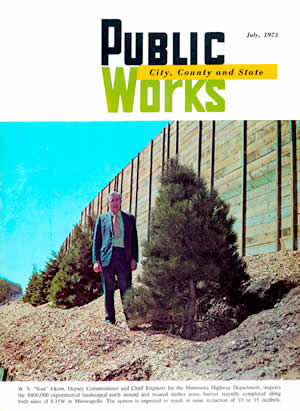 |
The department’s pioneering use of wooden walls, earthen berms and vegetation to lower freeway noise levels in nearby neighborhoods along Interstate 35W in Minneapolis earned front-page honors for Stan Ekern from Public Works magazine in July 1973. The publication named him its public works official of the year in 1974. Photo courtesy of Mike Ekern |
Ekern played a key role to enable Mn/DOT, then the Minnesota Department of Highways, to meet the challenges of building the interstate highway system in the state starting in the 1960s.
Former colleagues said he was a “hands-on” manager who was fully involved in developing new practices and equipment to meet the challenges of the massive interstate construction program.
Ekern was featured by Public Works magazine in a cover story about the use of noise walls in connection with building interstate freeways in the Twin Cities area. The publication named him its public works official of the year in 1974.
“He was a good supervisor, fair and straightforward,” said Ed Heinen, a retired manager in construction. “If you didn’t do your job, you heard about it.”
Dick Braun, a former commissioner, said Ekern was “an unsung hero, the guy behind the scenes who had the knack of solving knotty problems.”
“He was truly a remarkable public servant,” Braun said. “He was a genuine professional.”
Ekern remained active with the Minnesota Society of Professional Engineers long after his retirement and served on its scholarship committee.
Ekern’s survivors include his son, David, who is a former Mn/DOT assistant commissioner and now serves as Idaho’s commissioner of transportation, and two grandchildren.
By Craig Wilkins
|
back

|
 |
|
 |



